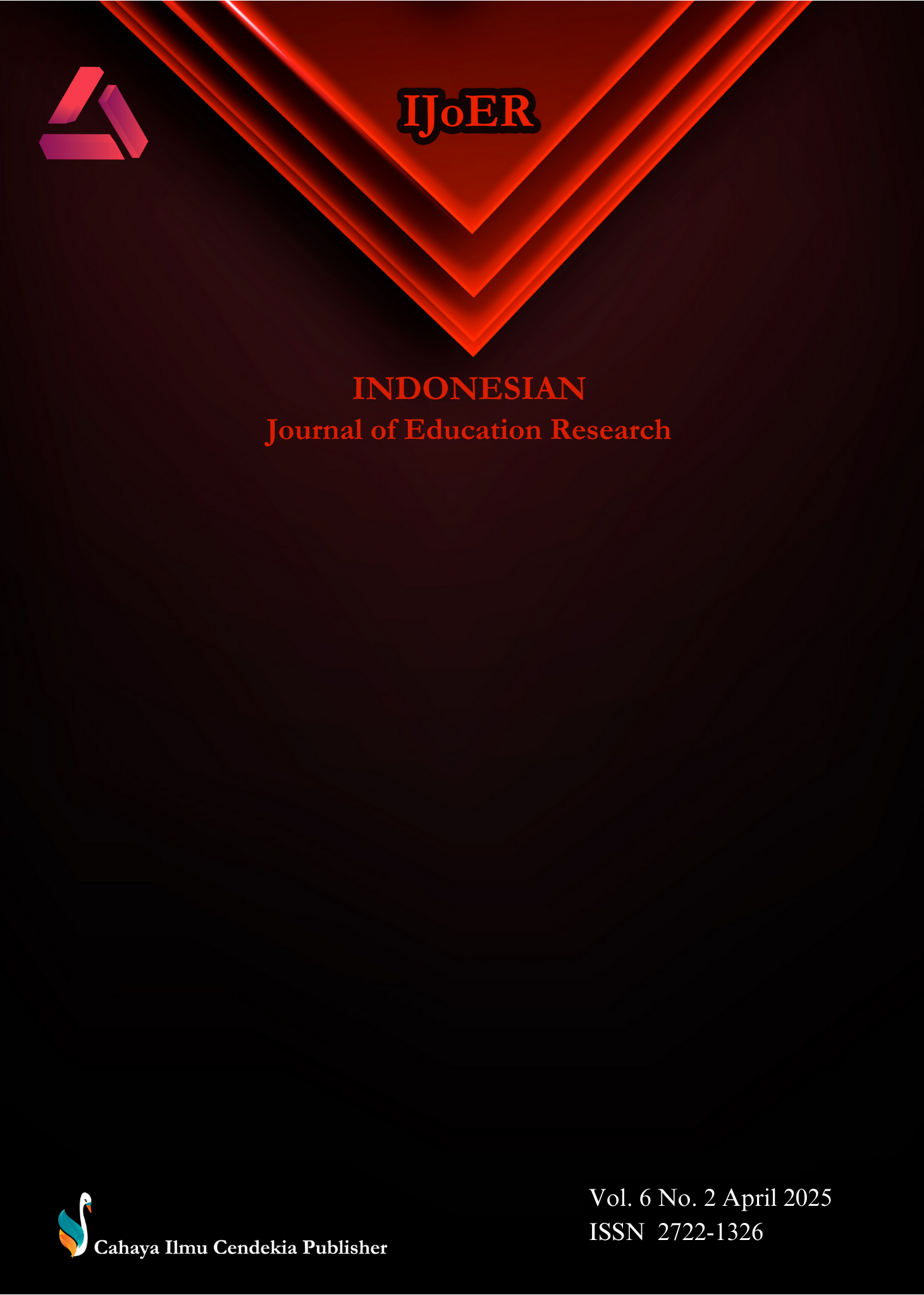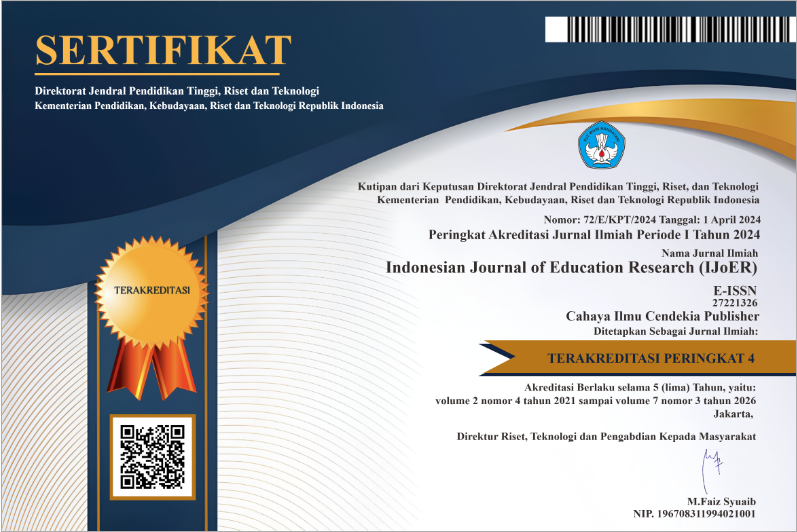Validating the Teacher Collective Efficacy Scale in the Cambodian Context: Exploratory and Confirmatory Factor Analyses
Abstract
Purpose of the Study: This study is part of a bigger quantitative research design aiming to extract the initial teacher collective efficacy and convergent validity.
Methodology: This study collected data from 619 teachers in secondary resource schools. Exploratory Factor Analysis (EFA) and Confirmatory Factor Analysis (CFA) were employed using SPSS and Mplus software to assess validity and reliability.
Main Findings: EFA identified two factors with eigenvalues of 5.13 and 1.54, accounting for 55.58% of the variation in teacher collective efficacy. The EFA results showed a single-dimensional factor representing teacher collective efficacy. CFA confirmed that all nine indicators had strong, statistically significant loadings (p < 0.001) ranging from 0.65 to 0.78. Fit indices (CFI = 0.97, TLI = 0.96, SRMR = 0.028, RMSEA = 0.057) indicated a very good model fit, supporting the construct validity of the scale.
Novelty/Originality of This Study: This study advances knowledge by validating the measurement of teacher collective efficacy through rigorous statistical analysis. It provides empirical evidence supporting the reliability and validity of the scale, contributing to a better understanding of collective efficacy in secondary resource schools.
References
A. W. Hoy, “What motivates teachers? Important work on a complex question,” Learn. Instr., vol. 18, no. 5, pp. 492–498, Oct. 2008, doi: 10.1016/j.learninstruc.2008.06.007.
K. Leithwood and D. Jantzi, “Linking Leadership to Student Learning: The Contributions of Leader Efficacy,” Educ. Adm. Q., vol. 44, no. 4, pp. 496–528, Oct. 2008, doi: 10.1177/0013161X08321501.
J. A. Ross and P. Gray, “Transformational leadership and teacher commitment to organizational values: The mediating effects of collective teacher efficacy,” Sch. Eff. Sch. Improv., vol. 17, no. 2, pp. 179–199, Jun. 2006, doi: 10.1080/09243450600565795.
M. Tschannen-Moran and A. W. Hoy, “Teacher efficacy: capturing an elusive construct,” Teach. Teach. Educ., vol. 17, no. 7, pp. 783–805, Oct. 2001, doi: 10.1016/S0742-051X(01)00036-1.
A. Bandura, Social learning theory. In the Prentice-Hall series in social learning theory. Englewood Cliffs, New Jersey: Prentice-Hall, 1977.
R. J. Sampson, J. D. Morenoff, and F. Earls, “Beyond Social Capital: Spatial Dynamics of Collective Efficacy for Children,” Am. Sociol. Rev.., vol. 64, no. 5, pp. 633–660, Oct. 1999, doi: 10.1177/000312249906400501.
R. D. Goddard, “Collective efficacy: A neglected construct in the study of schools and student achievement.” J. Educ. Psychol., vol. 93, no. 3, pp. 467–476, Sep. 2001, doi: 10.1037/0022-0663.93.3.467.
S. Gibson and M. H. Dembo, “Teacher efficacy: A construct validation.” J. Educ. Psychol., vol. 76, no. 4, pp. 569–582, Aug. 1984, doi: 10.1037/0022-0663.76.4.569.
R. Goddard, Y. Goddard, E. Sook Kim, and R. Miller, “A Theoretical and Empirical Analysis of the Roles of Instructional Leadership, Teacher Collaboration, and Collective Efficacy Beliefs in Support of Student Learning,” Am. J. Educ., vol. 121, no. 4, pp. 501–530, Aug. 2015, doi: 10.1086/681925.
R. D. Goddard, W. K. Hoy, and A. W. Hoy, “Collective Teacher Efficacy: Its Meaning, Measure, and Impact on Student Achievement,” Am. Educ. Res. J., vol. 37, no. 2, pp. 479–507, Jan. 2000, doi: 10.3102/00028312037002479.
R. D. Goddard, “The effects of collective teacher efficacy on student achievement in urban public elementary schools,” Published doctoral dissertation, The Ohio State University, 1998.
MoEYS, “Education in Cambodia: Findings from Cambodia’s experience in PISA for Development,” 2018.
OECD, PISA 2022 Results (Volume I): The State of Learning and Equity in Education. in PISA. OECD, 2023. doi: 10.1787/53f23881-en.
J. A. Ross and P. Gray, “Transformational leadership and teacher commitment to organizational values: The mediating effects of collective teacher efficacy,” Sch. Eff. Sch. Improv., vol. 17, no. 2, pp. 179–199, Jun. 2006, doi: 10.1080/09243450600565795.
R. Goddard, “A Theoretical and Empirical Analysis of the Measurement of Collective Efficacy: The Development of a Short Form,” Educ. Psychol. Meas., vol. 62, no. 1, pp. 97–110, Feb. 2002, doi: 10.1177/0013164402062001007.
E. M. Skaalvik and S. Skaalvik, “Dimensions of teacher self-efficacy and relations with strain factors, perceived collective teacher efficacy, and teacher burnout.” J. Educ. Psychol., vol. 99, no. 3, p. 611, 2007.
J. Donohoo, T. O’Leary, and J. Hattie, “The design and validation of the enabling conditions for collective teacher efficacy scale (EC-CTES),” J. Prof. Cap. Community, vol. 5, no. 2, pp. 147–166, Mar. 2020, doi: 10.1108/JPCC-08-2019-0020.
M. Tschannen-Moran, A. W. Hoy, and W. K. Hoy, “Teacher Efficacy: Its Meaning and Measure,” Rev. Educ. Res., vol. 68, no. 2, pp. 202–248, Jun. 1998, doi: 10.3102/00346543068002202.
R. D. Goddard, L. Skrla, and S. J. Salloum, “The Role of Collective Efficacy in Closing Student Achievement Gaps: A Mixed Methods Study of School Leadership for Excellence and Equity,” J. Educ. Stud. Placed Risk JESPAR, vol. 22, no. 4, pp. 220–236, Oct. 2017, doi: 10.1080/10824669.2017.1348900.
R. D. Goddard and Y. L. Goddard, “A multilevel analysis of the relationship between teacher and collective efficacy in urban schools,” Teach. Teach. Educ., vol. 17, no. 7, pp. 807–818, 2001.
M. Tschannen‐Moran and W. Hoy, “Trust in schools: a conceptual and empirical analysis,” J. Educ. Adm.., vol. 36, no. 4, pp. 334–352, Oct. 1998, doi: 10.1108/09578239810211518.
R. N. Anderson, M. L. Loewen, and L. Loewen, “Relationships among teachers’ and students’ thinking skills, sense of efficacy, and student achievement.” Alta. J. Educ. Res., vol. 34, no. 2, pp. 148–165, 1988.
P. T. Ashton and R. B. Webb, Making a Difference: Teachers’ Sense of Efficacy and Student Achievement. Longman, 1986.
A. Bandura, “Perceived Self-Efficacy in Cognitive Development and Functioning,” Educ. Psychol., vol. 28, no. 2, pp. 117–148, Mar. 1993, doi: 10.1207/s15326985ep2802_3.
R. D. Goddard, L. LoGerfo, and W. K. Hoy, “High School Accountability: The Role of Perceived Collective Efficacy,” Educ. Policy, vol. 18, no. 3, pp. 403–425, Jul. 2004, doi: 10.1177/0895904804265066.
J. A. Ross, A. Hogaboam-Gray, and P. Gray, “The Contribution of Prior Student Achievement and School Processes To Collective Teacher Efficacy in Elementary Schools,” University of Toronto, Apr. 2003.
M. Tschannen-Moran, A. W. Hoy, and W. K. Hoy, “Teacher Efficacy: Its Meaning and Measure,” Rev. Educ. Res., vol. 68, no. 2, pp. 202–248, Jun. 1998, doi: 10.3102/00346543068002202.
F. Pajares, “Self-Efficacy Beliefs in Academic Settings,” Rev. Educ. Res., vol. 66, no. 4, pp. 543–578, Dec. 1996, doi: 10.3102/00346543066004543.
S. Lim and S. Eo, “The mediating roles of collective teacher efficacy in the relations of teachers’ perceptions of school organizational climate to their burnout,” Teach. Teach. Educ., vol. 44, pp. 138–147, Nov. 2014, doi: 10.1016/j.tate.2014.08.007.
L. Stanley and S. Wise, “The ESRC’s 2010 Framework for Research Ethics: Fit for Research Purpose?” Sociol. Res. Online, vol. 15, no. 4, pp. 106–115, Nov. 2010, doi: 10.5153/sro.2265.
R. B. Kline, Principles and practice of structural equation modeling, Fifth edition. S.l.: GUILFORD, 2023.
J. F. Hair, W. C. Black, B. J. Babin, and A. Rolph E, Multivariate Data Analysis, 8th ed. Cengage Learning EMEA: Cengage Learning, 2019.
J. C. Nunnally, Psychometric theory, 3rd ed. New York, NY: McGraw-Hill, 1978.
L. R. Fabrigar, D. T. Wegener, R. C. MacCallum, and E. J. Strahan, “Evaluating the use of exploratory factor analysis in psychological research,” Psychol. Methods, vol. 4, no. 3, pp. 272–299, 1999, doi: 10.1037/1082-989X.4.3.272.
R. F. DeVellis, Scale development: Theory and applications, 4th ed. SAGE Publications, Inc., 2017.
A. B. Costello and J. W. Osborne, “Best Practices in Exploratory Factor Analysis: Four Recommendations for Getting the Most From Your Analysis,” Pract. Assess. Res. Eval., vol. 10, no. 7, 2005.
R. L. Worthington and T. A. Whittaker, “Scale Development Research: A Content Analysis and Recommendations for Best Practices,” Couns. Psychol., vol. 34, no. 6, pp. 806–838, Nov. 2006, doi: 10.1177/0011000006288127.
C. S Fornell and D. F. Larcker, “Evaluating Structural Equation Models with Unobservable Variables and Measurement Error,” J. Mark. Res., vol. 18, no. 1, pp. 39–50, 1981.
R. B. Kline, Principles and Practice of Structural Equation Modeling, 4th ed. The Guilford Press, 2016.
A. Field, Discovering statistics using IBM SPSS statistics: and sex and drugs and rock ‘n’ roll, 4th ed. 2013.
B. G. Tabachnick and L. S. Fidell, Using Multivariate Statistics, 6th ed. Pearson, 2019.
R. K. Henson and J. K. Roberts, “Use of Exploratory Factor Analysis in Published Research: Common Errors and Some Comment on Improved Practice,” Educ. Psychol. Meas., vol. 66, no. 3, pp. 393–416, Jun. 2006, doi: 10.1177/0013164405282485.
Thompson, Exploratory and confirmatory factor analysis: Understanding concepts and applications. American Psychological Association, 2004.
D. L. Paulhus, “Measurement and Control of Response Bias,” in Measures of Personality and Social Psychological Attitudes, Elsevier, 1991, pp. 17–59. doi: 10.1016/B978-0-12-590241-0.50006-X.
T. A. Brown, Confirmatory factor analysis for applied research, 2nd ed. The Guilford Press, 2015.
R. D. Goddard, W. K. Hoy, and A. W. Hoy, “Collective Efficacy Beliefs: Theoretical Developments, Empirical Evidence, and Future Directions,” Educ. Res., vol. 33, no. 3, pp. 3–13, Apr. 2004, doi: 10.3102/0013189X033003003.
Copyright (c) 2025 Somphors Khan, Sarom Mok, Rany Sam, Sereyrath Em

This work is licensed under a Creative Commons Attribution 4.0 International License.
Authors who publish with this journal agree to the following terms:
- Authors retain copyright and acknowledge that the Indonesian Journal of Education Research (IJoER) is the first publisher licensed under a Creative Commons Attribution 4.0 International License.
- Authors are able to enter into separate, additional contractual arrangements for the non-exclusive distribution of the journal's published version of the work (e.g., post it to an institutional repository or publish it in a book), with an acknowledgment of its initial publication in this journal.
- Authors are permitted and encouraged to post their work online (e.g., in institutional repositories or on their website) prior to and during the submission process, as it can lead to productive exchanges and earlier and greater citation of published work.







.png)
.png)




















